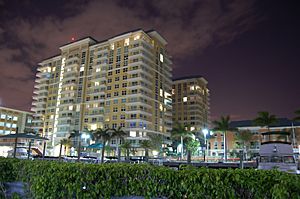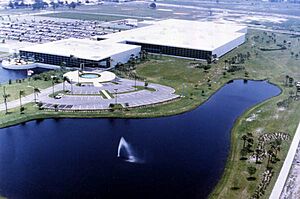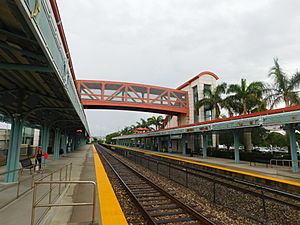Boynton Beach, Florida facts for kids
Quick facts for kids
Boynton Beach, Florida
|
|||||
|---|---|---|---|---|---|

Marina Village of Boynton Beach
|
|||||
|
|||||
| Nicknames:
Boynton, B-town
|
|||||
| Motto(s):
America's Gateway to the Gulfstream
|
|||||

Location within Palm Beach County and Florida
|
|||||
| Country | |||||
| State | |||||
| County | Palm Beach | ||||
| Settled (Boynton Settlement) | 1895 | ||||
| Incorporated | 1920 | ||||
| Government | |||||
| • Type | Commission-Manager | ||||
| Area | |||||
| • Total | 16.57 sq mi (42.91 km2) | ||||
| • Land | 16.16 sq mi (41.85 km2) | ||||
| • Water | 0.41 sq mi (1.06 km2) 2.3% | ||||
| Elevation | 20 ft (6 m) | ||||
| Population
(2020)
|
|||||
| • Total | 80,380 | ||||
| • Density | 4,974.93/sq mi (1,920.85/km2) | ||||
| Time zone | UTC-5 (Eastern (EST)) | ||||
| • Summer (DST) | UTC-4 (EDT) | ||||
| Zip Codes |
33424–33426, 33435–33437,33474
|
||||
| Area code(s) | 561, 728 | ||||
| FIPS code | 12-07875 | ||||
| GNIS feature ID | 0279303 | ||||
Boynton Beach is a city in Palm Beach County, Florida, United States. It's located about 57 miles (92 km) north of Miami. In 2020, about 80,380 people lived there. Boynton Beach is part of the larger Miami metropolitan area, which had over 6 million people in 2020.
The city is named after Nathan Boynton, a Civil War major and politician from Michigan. He was one of the first settlers in the area in 1895. Boynton Beach is north of Delray Beach and south of Hypoluxo and Lantana. To the east, across the Intracoastal Waterway, are smaller towns like Briny Breezes and Ocean Ridge.
Thousands of years ago, Native Americans lived in the area that is now Boynton Beach. Ancient artifacts found nearby date back to about 150 BCE. The first non-native settlers arrived in 1877. Major Boynton came in 1895 and built the Boynton Hotel. He also brought many people from Michigan, who started farms and businesses.
The "Town of Boynton" was officially created in 1898, but it wasn't officially a city until 1920. The part of Boynton Beach right on the ocean became its own town in 1931, later named Ocean Ridge in 1939. Boynton Beach's population grew a lot after World War II, especially in the 1950s. The city also expanded westward, particularly in the 1980s.
Today, Boynton Beach is the third-largest city in Palm Beach County. Only West Palm Beach and Boca Raton are bigger. The area along Congress Avenue has many restaurants and shops, including the Boynton Beach Mall. The city also has places for arts and culture, like the Boynton Woman's Club and the Schoolhouse Children's Museum & Learning Center.
Contents
History of Boynton Beach

Early Inhabitants and Settlers
Evidence from archaeological digs shows that Native American groups lived here thousands of years ago. Tribes like the Ais and Jaega were in or near what is now Palm Beach County. A group of ancient mounds west of Boynton Beach contains pieces of pottery from around 150 BCE. Other items found there, like beads and glass, suggest contact with the Spanish in the 16th century.
The first land claim in modern-day Boynton Beach was made in 1875. Two years later, Dexter Hubel and his family from Michigan settled in the area. They had to stay in a temporary house until their own home was built.
Major Boynton's Arrival and Growth
In 1894, before the railroad was built, Nathan Boynton, a former Civil War major, discovered this beautiful area. He was from Port Huron, Michigan. He loved the sunny weather and beaches so much that he built the famous Boynton Hotel. He and his family spent winters there.
The hotel opened in 1897 and could host 100 guests. Major Boynton passed away in 1911, but his hotel stayed open until 1925. Around the late 1890s, other buildings and homes appeared along Ocean Avenue. The first post office opened in 1896.
Farming and Community Building
The first settlers, many of whom came with Major Boynton from Michigan, soon learned that many fruits and vegetables grew well in the rich soil. They grew pineapples, tomatoes, mangoes, and citrus fruits. These crops were packed and sent across the country by the new Florida East Coast Railroad. Two African American farmers, Alonzo King and Samuel Cade, taught these early settlers how to farm in the local soil and deal with mosquitoes and snakes.
Boynton Beach was officially founded on September 26, 1898. Byrd Spilman Dewey and her husband, Fred S. Dewey, officially registered the "Town of Boynton." Fred S. Dewey, who worked for Henry Flagler (a railroad builder), bought a large area of land. He divided it into smaller plots for farming, which he sold to settlers and hotel workers.
Education and Infrastructure
A wooden schoolhouse opened in 1900, replacing an older, smaller building. By then, the town had 83 people. By 1904, a second school building was needed because the community was growing so fast. In 1913, a larger concrete school with six classrooms was built. This building is now the Schoolhouse Children's Museum & Learning Center and is a historic site.
In 1911, the first bridge across the Intracoastal Waterway opened at Ocean Avenue. That same year, the Boynton Woman's Club started the town's first library. The 1910s also saw the first bank open in 1915 and the first ocean road (State Road A1A) built in 1916.
Official Incorporation and Name Change
The Town of Boynton officially became a city in 1920. Forty-eight out of 50 voters approved the change. G. E. Coon became the first mayor. Before this, the 1920 census showed 671 people in the area. The name "Boynton Beach" was first used by a community that separated from the Town of Boynton in 1931. In 1939, that community changed its name to "Ocean Ridge." The Town of Boynton then took the name "Boynton Beach" in 1941.
Utility services began in the early 1920s. Electricity arrived in 1921, along with a sewage system. A city water system started in 1923, and telephone service came by the end of the 1920s.
Boynton Beach Oceanfront Park
Boynton Beach Oceanfront Park is located near where the original Boynton Hotel stood. The city bought this beach area in 1921 for public use. A beach casino was built in 1928 with a dining hall and locker rooms. It was a popular spot for parties. The casino was taken down in 1967, but the land remained part of the park.
The park has been popular with locals and visitors for many years. In the mid-1990s, the park was updated, and its boardwalk was rebuilt using recycled plastic. In 2001, The Palm Beach Post newspaper named Boynton Beach's Oceanfront Park the best family beach in Palm Beach County. The boardwalk was updated again in 2011 with a strong wood called ipe (Brazilian walnut). In 2012, the buildings along the boardwalk were also improved.
Development and Challenges
In 1926, the Seaboard Air Line Railway came to Boynton. This led to new housing developments further inland, like Lake Boynton Estates. As land became more valuable, areas along the Intracoastal Waterway also saw new homes. To the west, many dairy farms were started, making Boynton the main milk supplier for Palm Beach County. By the 1970s, these farms were no longer profitable, and their lands were also turned into housing.
Between 1926 and 1928, three hurricanes hit Boynton. The 1928 Okeechobee hurricane caused a lot of damage. It destroyed 46 homes and 18 other buildings, including the town hall. Many other homes and buildings were damaged, and 56 families lost their homes. The city government struggled financially after the hurricane and during the Great Depression. However, they received help from the state and federal governments to rebuild roads and bridges.
Post-War Growth and Modern Era
Boynton Beach grew very quickly in the 1950s. Its population jumped from 2,542 people in 1950 to 10,467 in 1960. New buildings included a city hall in 1958 and Bethesda Memorial Hospital in 1959. The city also bought more coastal land to expand its beach recreation areas.

In the 1960s, a civic center, a public library, and a new water treatment plant were built. A second bridge across the Intracoastal Waterway opened in 1967. The construction of Interstate 95 through the city began, finishing in 1977. Roads like Boynton Beach Boulevard and Congress Avenue were also extended. Large housing projects like Hampshire Gardens and Leisureville were built, bringing more people and economic growth.
The 1980s brought a big economic boost to Boynton Beach. Motorola opened a new paging plant in 1983, which employed about 3,500 people at its busiest. The Boynton Beach Mall opened in 1985, and Tri-Rail train service started in 1989, with a station in Boynton Beach. These additions attracted more businesses and led to fast population growth in the city's western areas.
Hurricane Wilma hit Boynton Beach on October 24, 2005, causing widespread damage. In 2006, the city decided to take down the old Seaboard rail station, which had been there since 1971.
In 2022, Ty Penserga was elected mayor of Boynton Beach. He is the first openly gay mayor of the city and the first openly LGBTQ Asian American mayor elected in Florida. He is a high school biology and chemistry teacher.
Population Information
| Historical population | |||
|---|---|---|---|
| Census | Pop. | %± | |
| 1930 | 1,053 | — | |
| 1940 | 1,326 | 25.9% | |
| 1950 | 2,542 | 91.7% | |
| 1960 | 10,467 | 311.8% | |
| 1970 | 18,115 | 73.1% | |
| 1980 | 35,624 | 96.7% | |
| 1990 | 46,194 | 29.7% | |
| 2000 | 60,389 | 30.7% | |
| 2010 | 68,217 | 13.0% | |
| 2020 | 80,380 | 17.8% | |
| U.S. Decennial Census | |||
| Historical demographics | 2020 | 2010 | 2000 | 1990 | 1980 |
|---|---|---|---|---|---|
| White (non-Hispanic) | 47.3% | 53.6% | 64.4% | 73.5% | 78.3% |
| Hispanic or Latino | 15.4% | 12.8% | 9.2% | 6.8% | 4.0% |
| Black or African American (non-Hispanic) | 30.6% | 29.6% | 22.5% | 19.0% | 17.2% |
| Asian and Pacific Islander (non-Hispanic) | 2.4% | 2.1% | 1.5% | 0.6% | 0.5% |
| Native American (non-Hispanic) | 0.1% | 0.1% | 0.1% | 0.1% | |
| Some other race (non-Hispanic) | 0.7% | 0.3% | 0.2% | < 0.1% | |
| Two or more races (non-Hispanic) | 3.4% | 1.5% | 2.0% | N/A | N/A |
| Population | 80,380 | 68,217 | 60,389 | 46,194 | 35,624 |
2020 Census Data
| Race / Ethnicity (NH = Non-Hispanic) | Pop 2000 | Pop 2010 | Pop 2020 | % 2000 | % 2010 | % 2020 |
|---|---|---|---|---|---|---|
| White (NH) | 38,897 | 36,534 | 37,989 | 64.41% | 53.56% | 47.26% |
| Black or African American (NH) | 13,585 | 20,218 | 24,604 | 22.50% | 29.64% | 30.61% |
| Native American or Alaska Native (NH) | 82 | 100 | 92 | 0.14% | 0.15% | 0.11% |
| Asian (NH) | 898 | 1,438 | 1,896 | 1.49% | 2.11% | 2.36% |
| Pacific Islander or Native Hawaiian (NH) | 24 | 21 | 18 | 0.04% | 0.03% | 0.02% |
| Some other race (NH) | 105 | 179 | 602 | 0.17% | 0.26% | 0.75% |
| Mixed race or Multiracial (NH) | 1,234 | 1,025 | 2,763 | 2.04% | 1.50% | 3.44% |
| Hispanic or Latino (any race) | 5,564 | 8,702 | 12,416 | 9.21% | 12.76% | 15.45% |
| Total | 60,389 | 68,217 | 80,380 | 100.00% | 100.00% | 100.00% |
According to the 2020 United States census, Boynton Beach had 80,380 people. There were 30,370 households and 17,274 families living in the city.
In 2010, there were 68,217 people and 29,172 households. About 19.8% of the homes were empty. The population density was about 4,217.5 people per square mile (1,628.4 per km²).
In 2010, about 21.5% of the people were 65 or older, and 19.3% were under 18. The average age was 41.4 years. For every 100 females, there were about 89 males. About 25.1% of households had children under 18 living with them.
Economy and Jobs
In 2021, Boynton Beach had a workforce of 41,266 people. The largest employers in 2020 were Bethesda Memorial Hospital and the city government. The hospital employed 2,579 people, and the city government employed 843 people.
Many people who work in Boynton Beach actually live in other nearby cities. The most common jobs in 2021 were in education, healthcare, retail, and professional services. There were also many jobs in arts, entertainment, and food services.
Schools in Boynton Beach
Boynton Beach is part of the School District of Palm Beach County. This is one of the largest school districts in Florida and in the United States.
Elementary schools:
- Citrus Cove Elementary School
- Crosspointe Elementary
- Forest Park Elementary
- Manatee Elementary
- Galaxy Elementary School
- Poinciana Elementary School (magnet school for math, science and technology)
Middle schools:
- Congress Middle School
High schools:
- Boynton Beach Community High School
- South Tech Academy Charter High School
Historic Preservation Efforts
The Boynton Beach Historical Society was started in 1968. Its goal is to keep the traditions and history of Boynton Beach alive. They collect and share historical items and help people learn more about the city's past. The society's records are kept at the Boynton Beach Public Library. They also have materials about the history of nearby towns.
The city has a board that lists 170 historic sites. These include old buildings, bridges, cemeteries, and churches. There are also two "heritage trails" that highlight important historical places downtown and three historic cemeteries. Two buildings in Boynton Beach are listed on the National Register of Historic Places: the Boynton Woman's Club and the Boynton School (now the Schoolhouse Children's Museum & Learning Center).
Getting Around: Public Transportation
Boynton Beach has a Tri-Rail station. This train connects Boynton Beach to West Palm Beach to the north and Miami to the south. Local buses are also available, provided by PalmTran.
Arts and Culture
Boynton Beach has an arts district. In 2017, it was recognized as one of South Florida's "emerging neighborhoods" for its growing arts scene.
Famous People from Boynton Beach
Many notable people have lived in or are from Boynton Beach:
- Tanner Anderson, MLB and Chinese Professional Baseball League player
- Ramon Perez Blackburn, actor-singer-dance
- Danielle Bregoli, rapper, social media personality
- Marlon Byrd, former MLB outfielder
- Jeremy Cain, former NFL long snapper
- Hector Camacho, Puerto Rican boxer
- Hillary Cassel, Florida House of Representatives member
- Noah Centineo, actor
- Charles Cornelius, former NFL and CFL player
- Byrd Spilman Dewey, author and town of Boynton co-founder
- Craig Erickson, former NFL quarterback
- Johnny Farrell, golfer, 1928 U.S. Open champion
- Gar Finnvold, former MLB player
- Brandon Fletcher, Internet entrepreneur
- James J. Greco, businessman
- Jayron Hosley, former NFL cornerback
- Lamar Jackson, NFL quarterback, 2019 NFL MVP
- Kelani Jordan, professional wrestler, WWE NXT
- Ricardo Jordan, former MLB pitcher
- Michael Kelly (baseball), MLB player
- Ryan Klesko, MLB player
- Sean Labanowski, Israeli-American basketball player
- Dov Markus, Israeli-American soccer player
- Vincent Mason, rapper, producer, DJ, and one third of hip hop trio De La Soul
- Hilary McRae, singer, songwriter
- Tristan Nunez, racing driver
- Almerin C. O'Hara, US Army major general
- Titus O'Neil, professional wrestler
- Harvey Eugene Oyer III, attorney and author
- Charlie W. Pierce, Florida pioneer and author
- Rick Rhoden, former MLB player
- Otis Thorpe, NBA basketball player
- Trea Turner, MLB Player, 2019 World Series champion
- Howard E. Wasdin, sniper in Navy SEAL Team Six
- Vince Wilfork, former NFL nose tackle, two-time Super Bowl champion
- Mark Worrell, MLB Player
- Danny Young, MLB player
See also
 In Spanish: Boynton Beach para niños
In Spanish: Boynton Beach para niños








